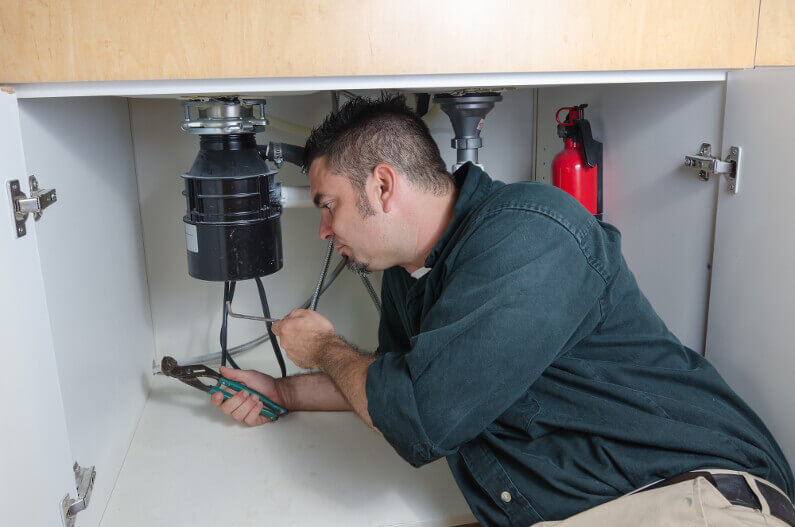Are you using and cleaning your garbage disposal properly? Like any other home appliance, garbage disposals require maintenance. If you fail to take certain precautions, having a new one repaired or installed can set you back a few hundred dollars, not including the cost of labor.
Maintaining your disposal only requires a few minutes of routine care per week. Here are our top six tips to help you avoid garbage disposal repair and installation of a new one.
1. Know What Foods Are Off Limits
Garbage disposals may have powerful blades, but that doesn’t mean they were designed to tackle anything you toss into it.
Hard and stringy foods such as bones, fruit pits, corn cobs, celery, and onion skins should never go into a garbage disposal. Hard solids can damage the motor, while stringy waste can actually get twisted around the blades. That means you’ll need to shut it off and try to manually untangle the gunk yourself so the grinder can cut up other food you place in it.
There are some extra powerful garbage disposals on the market that are capable of grinding up hard waste such as bones, but even these need to be used with caution. Hard food particles enter your town or city’s sewage and unfortunately, require more work to keep them out of wastewater.
What about eggshells and coffee grinds? Believe it or not, these objects can get wedged in the shredder ring and bring the machine to a halt. They should never be placed in a garbage disposal.
Another food product you should never pour down the disposal is any kind of grease or oil. It isn’t so much that these fats will hurt the blades themselves, but they’ll solidify in your pipes and clog them up.
As water and oil doesn’t mix, this can cause a real plumbing nightmare. These types of blockages can be a real challenge for plumbers to eliminate. Thinking that your disposal can break up fat is a leading cause of sink drain clogs.
And avoid scraping starchy foods including rice, potatoes, and pasta into your disposal, unless it’s a really small amount. Like grease and oil, these foods can turn goopy and block up the pipe.
2. Don’t Use It to Eliminate All of Your Scraps
Many people mistakenly think they can use their disposal to grind up large amounts of leftovers or plate scraps. In reality, the appliance wasn’t designed to eliminate high amounts of food and should really only be used to prevent food particles from building up in the sink strainer.
So how should you properly get rid of your table scraps? Scrape what you can into the compost collection bin or the trash can, and then rinse the last remaining bits off into the running disposal before washing the dish.
3. Never Use it For Non-Food Items
It seems like that should be obvious, but some people do think a garbage disposal can substitute for a trash can. Anything that’s not food doesn’t belong in a garbage disposal. All it will do is end up doing is cause a major sewage issue for your town or city and potentially damage your machine and pipes.
Anything that is not biodegradable food doesn’t belong in a garbage disposal. That include glass, plastic, cigarette butts, or even paper.
4. Clean it Regularly
Food builds up on your garbage disposal, making it smelly and gunky looking fast. Keeping it clean will help it do its job better.
There are several household products you can pour into the disposal to clean it. One is dishwashing soap with some ice cubes (the one exception to not putting anything hard down your disposal.) The appliance can break up the ice which will remove the gunk.
White vinegar and baking soda is another good cleaning combination for your disposal. Sprinkle the baking soda into the disposal first, then carefully pour in the vinegar with the machine running. The two create a foaming action when combined that will clean surfaces and eliminate any odors.
You can also run cut up citrus peels through the disposal to help freshen the smell. The citrus peels release a fragrant oil when they are ground up.
Avoid using bleach and other chemical cleaners to wash the disposal. They can corrode the pipes, requiring plumbing services to fix them.
Whatever cleaning method you use, you can rinse the disposal with cool or warm water to flush away any lingering odor. Refer to your owner’s manual for other recommended methods to keep your disposal clean and fresh.
5. Don’t Worry About Sharpening It
Contrary to popular belief, garbage disposals don’t have blades that need to be sharpened. Instead they have blunt impellers that grind up the food.
This doesn’t mean that it’s safe to put your hands into a garbage disposal to try to clean or untangle it. The machinery can still cause serious lacerations and fractures to your hand.
If you must access it, always make sure it’s shut off first before you reach into it. Better still, use tongs instead of your fingers to pull out any stuck food waste.
6. Run it Every Few Days
The disposal’s grinders can start to rust if you don’t use the unit regularly. Even if you don’t have any food to place in it, turn it on while running cool water into it for a couple of minutes a few times a week. This will help prevent rust while also rinsing away any leftover food particle clinging to it since the last time you used it.
Prevent Garbage Disposal Repair and Installation
Know how to prevent garbage disposal repair and installation by following these tips. They will help your unit last much longer and you avoid a service call.
If it’s too late and you have a garbage disposal that is not working, contact us at Plumb Time Plumbing and Drain Services. We’ll be happy to get it back up and running for you promptly.










